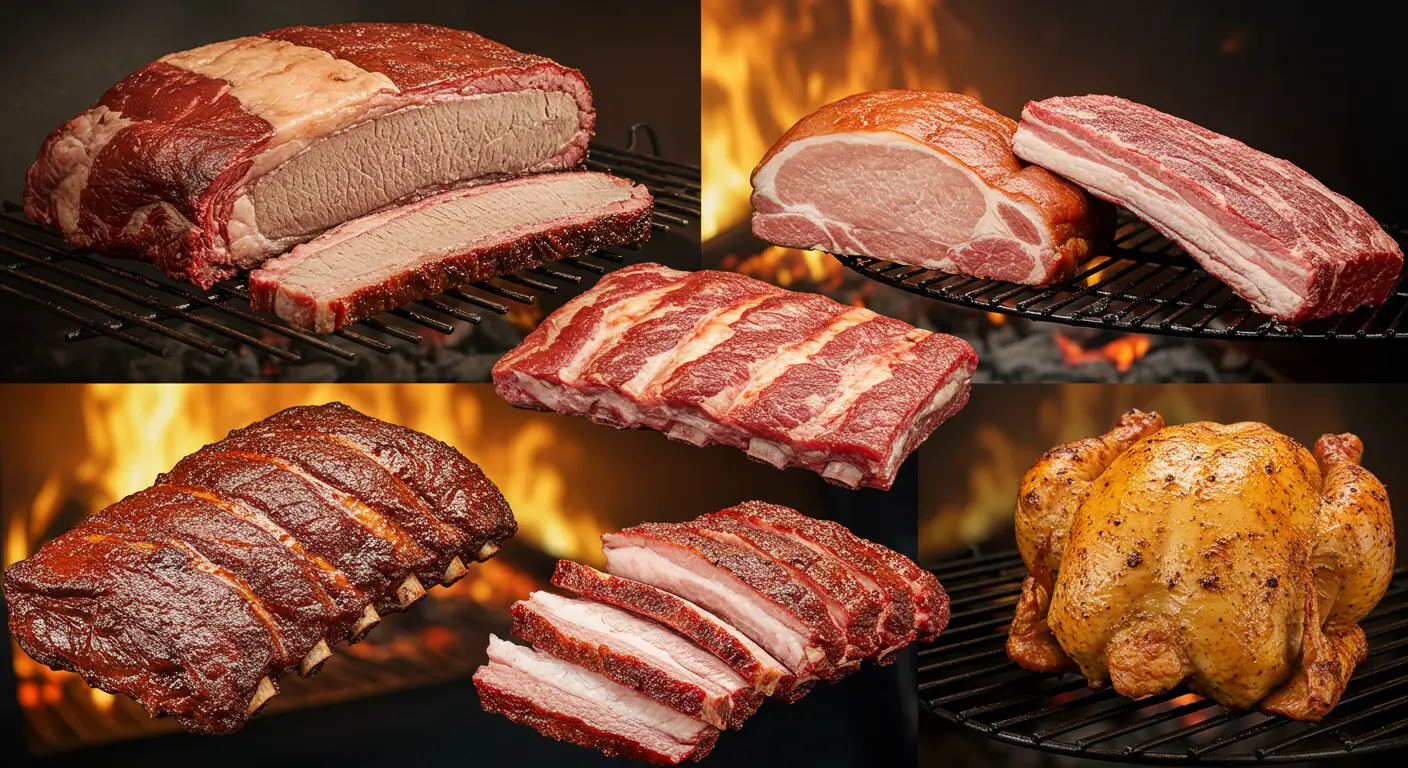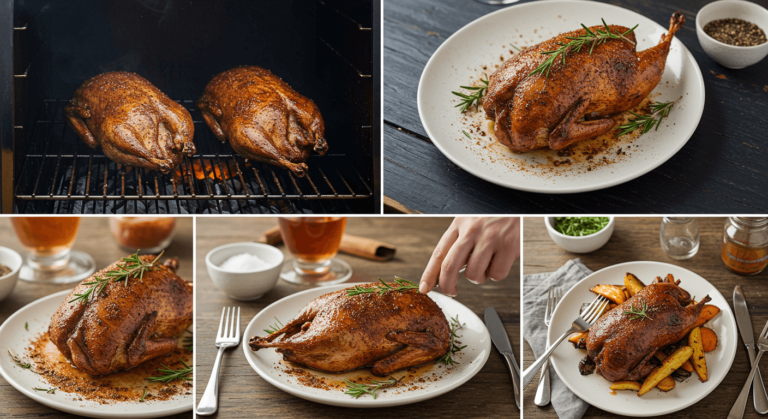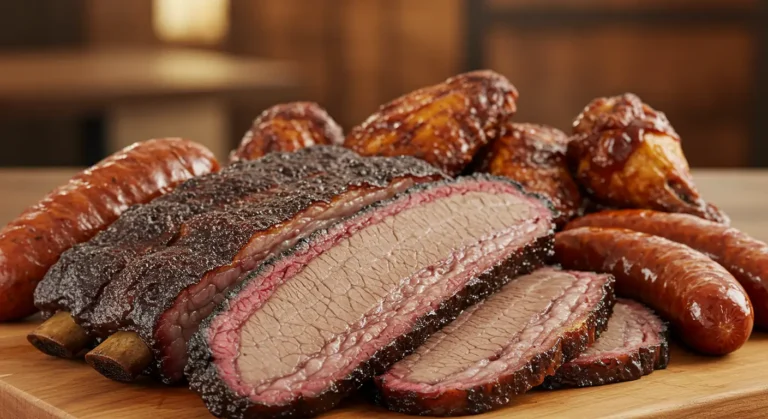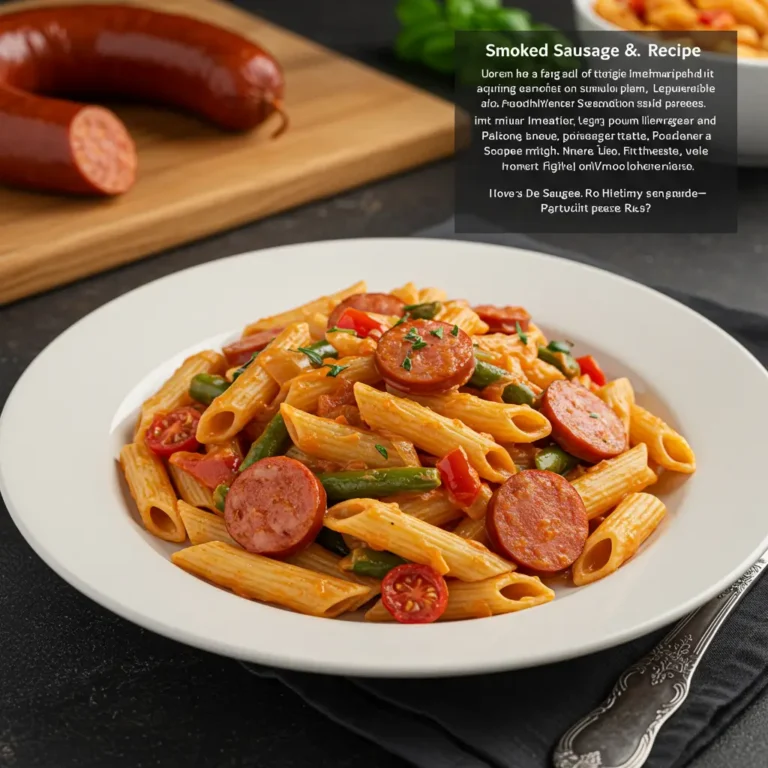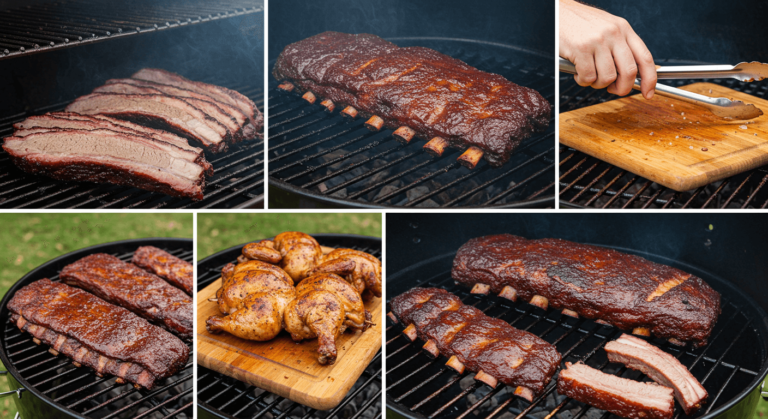Best Meat to Smoke for Tender Results: The Ultimate Guide
best meat to smoke
The distinct aroma of wood smoke drifting through the neighborhood is enough to make anyone’s mouth water. There’s something primal and deeply satisfying about the process of smoking meat—the patient tending of the fire, the gradual transformation of tough cuts into tender morsels, and finally, that moment when you slice into your creation to reveal a perfect smoke ring.
Whether you’re a newcomer who recently invested in your first smoker or a seasoned pitmaster looking to refine your technique, this guide will walk you through everything you need to know about selecting and smoking the best meats for incredibly tender results. We’ll cover the fundamentals of smoking, explore various types of smokers, and dive into specific cuts that yield the most succulent outcomes—all while focusing on humane meat options.
What Makes Smoking Different from Other Cooking Methods?
“Smoking isn’t just cooking—it’s a transformation,” explains award-winning BBQ chef Marcus Johnson. “The magic happens in that sweet spot where time, temperature, and smoke converge.”
Unlike grilling or roasting, smoking is a low-and-slow cooking method that breaks down tough connective tissues in meat while infusing it with complex flavors from the wood smoke. This dual process is what creates the distinctive texture and taste that’s impossible to replicate with other cooking techniques.
The Art and Science of Smoking Food
Understanding the Smoking Process
At its core, smoking is about two things: gentle heat and flavorful smoke. Most smoking happens between 225-275°F—significantly lower than other cooking methods. This low temperature allows the meat to cook gradually, giving collagen and tough fibers time to dissolve into gelatin, resulting in that fall-apart tenderness smoking is famous for.
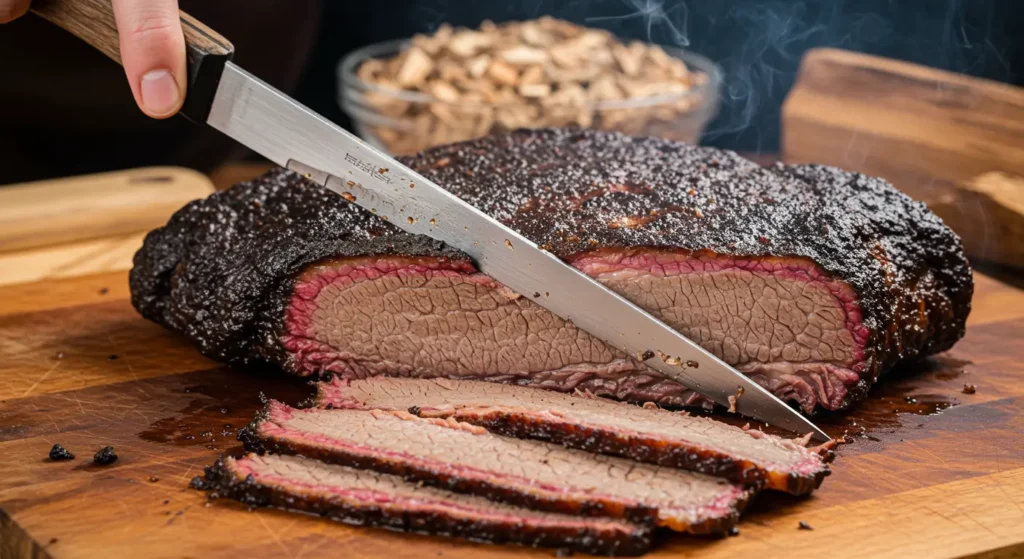
The Wood Factor: Flavor Profiles
Different woods impart distinct flavors to your meat:
- Hickory: Bold and bacon-like, excellent for beef
- Oak: Medium strength, versatile for most meats
- Maple: Mild and sweet, good for poultry
- Mesquite: Strong and earthy, use sparingly
- Cherry: Mild and sweet with a beautiful color effect
- Apple: Mild and fruity, excellent for poultry and game
“Wood selection isn’t just about flavor—it’s about creating harmony with your chosen meat,” notes pitmaster Sarah Williams. “A mild wood like apple won’t overpower delicate poultry, while a robust cut of beef can stand up to the stronger character of hickory.”
Temperature Control and The Stall
The key to successful smoking is maintaining consistent temperature. Most pitmasters agree that 225-250°F is the ideal range for most smoking applications.
You’ll likely encounter “the stall”—a phenomenon where the internal temperature of your meat plateaus (usually around 150-170°F) and seems to stop rising for hours. This happens because moisture evaporating from the meat’s surface creates a cooling effect. Many beginners panic at this point and raise the temperature, which can ruin the end result.
Solutions for managing the stall:
- Patience: Simply wait it out (the purist approach)
- The Texas Crutch: Wrapping the meat in foil or butcher paper to push through the stall faster
- Water pans: Using water pans in your smoker to stabilize the cooking environment
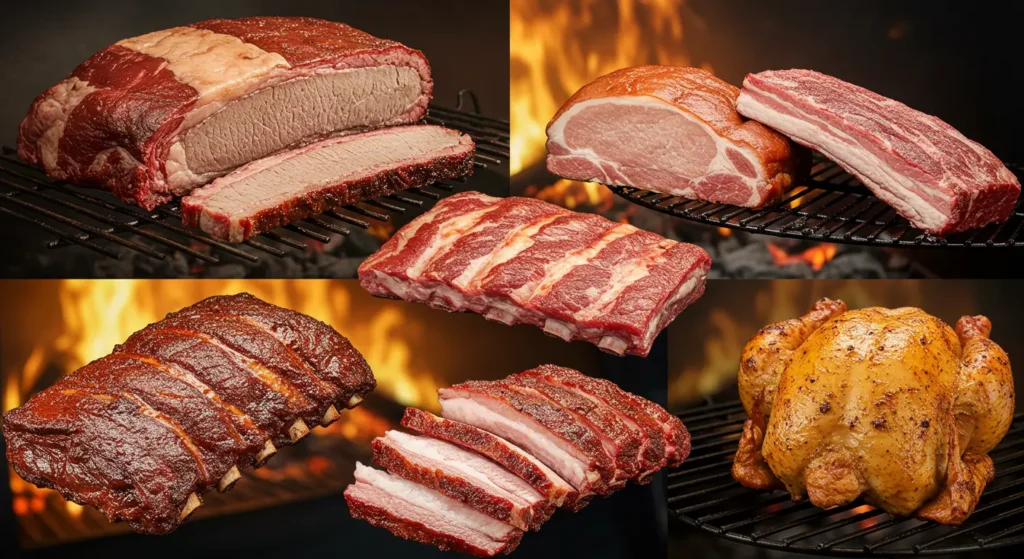
What Type of Smoker Should You Use?
Offset Smokers
These traditional “stick burners” feature a firebox attached to the side of the main cooking chamber. They’re beloved by purists for their authenticity but require more skill to manage.
Electric Smokers
Perfect for beginners, electric smokers offer convenience and steady temperature control. While they produce excellent results, some enthusiasts feel they lack the authentic experience of managing a fire.
Pellet Smokers
These modern marvels combine convenience with authentic flavor. The computer-controlled system feeds wood pellets to maintain your set temperature, making them incredibly user-friendly while still producing excellent results.
Ceramic Kamado Smokers
These egg-shaped cookers offer excellent insulation and temperature stability. They’re versatile but come with a steeper learning curve and higher price tag.
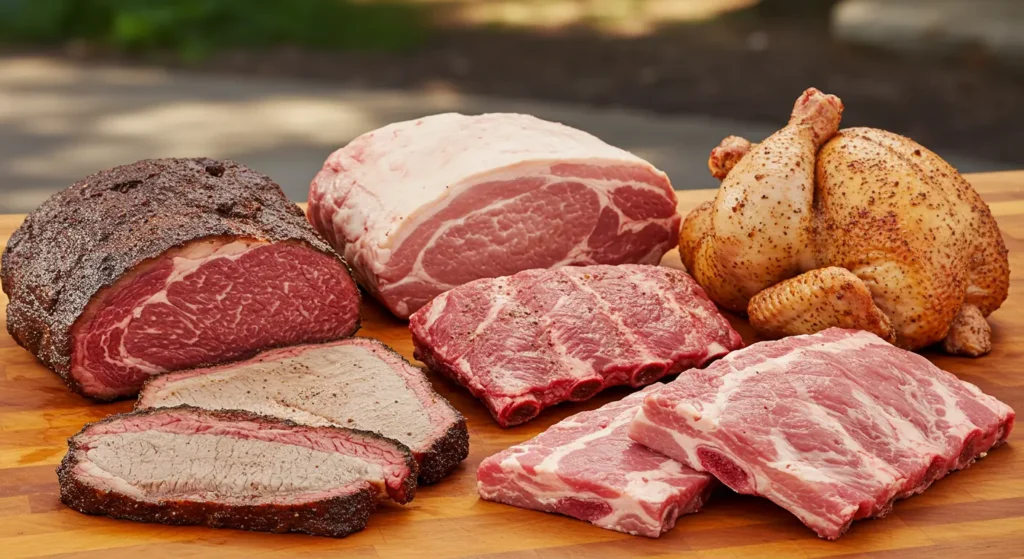
Drum Smokers
Simple in design but effective in practice, drum smokers are affordable options that produce competition-quality results when used correctly.
“The best smoker is the one you’ll actually use,” advises competition champion David Martinez. “I’ve tasted championship-winning brisket from $100 drum smokers and disappointing results from $2,000 setups. It’s the cook, not the cooker.”
What Are the Best Meats for Smoking?
The ideal smoking candidates share certain characteristics: they typically have abundant connective tissue, good fat content, and can withstand long cooking times without drying out. Here’s a comprehensive breakdown of the best options:
Beef Options for Smoking
Brisket: The King of Smoked Meats
This challenging but rewarding cut is considered the ultimate test of a pitmaster’s skill.
Why it works: The high collagen content breaks down during long smoking, resulting in incredibly tender meat when done properly.
Selection tips: Look for choice or prime grade with good marbling and a thick, uniform flat. Aim for 12-14 pounds before trimming.
Wood pairing: Oak or hickory
Expected time: 1-1.5 hours per pound at 250°F (12-18 hours total)
Doneness temperature: 203°F internal temperature
Humane considerations: Seek grass-fed, free-range options from local farms that practice ethical raising methods.
Beef Ribs
Massive, meaty, and marvelous—beef ribs create a stunning presentation and deliver incredible flavor.
Why they work: The significant intramuscular fat renders slowly, basting the meat from within.
Selection tips: Look for plate ribs (also called dinosaur ribs) with plenty of meat coverage.
Wood pairing: Oak, hickory, or cherry for color
Expected time: 6-8 hours at 250°F
Doneness temperature: 200-205°F, or when they pass the “bend test”
Chuck Roast: The “Poor Man’s Brisket”
This affordable cut delivers similar satisfaction to brisket with less cooking time and cost.
Why it works: Rich marbling and plenty of connective tissue make it perfect for transformation in the smoker.
Wood pairing: Hickory or oak
Expected time: 5-6 hours at 250°F
Doneness temperature: 195-205°F
Poultry Options for Smoking
Whole Chicken
Affordable and forgiving, smoked chicken is an excellent entry point for beginners.
Why it works: The skin protects the meat while absorbing smoke flavor, and the relatively quick cooking time makes it manageable for newcomers.
Selection tips: Look for birds in the 4-5 pound range, preferably free-range and organic.
Wood pairing: Apple, cherry, or maple
Expected time: 3-4 hours at 250°F
Doneness temperature: 165°F in the thigh
Pro tip: Spatchcock (butterfly) the chicken to reduce cooking time and ensure even doneness.
Turkey
Perfect for holidays and special occasions, smoked turkey offers a flavor profile that oven-roasting simply can’t match.
Why it works: The mild meat takes smoke flavor beautifully, and the long cooking process keeps it moist.
Selection tips: Choose birds under 15 pounds for best results.
Wood pairing: Apple or cherry
Expected time: 30-40 minutes per pound at 250°F
Doneness temperature: 165°F in the thigh
Duck
This rich, flavorful bird is transformed by smoking.
Why it works: The fat content renders slowly, creating crispy skin and moist meat.
Wood pairing: Cherry or apple
Expected time: 3-4 hours at 250°F
Doneness temperature: 165°F in the thigh
Game Meats for Smoking
Venison
With its lean nature, venison benefits tremendously from the gentle cooking process of smoking.
Why it works: The slow cooking prevents this lean meat from becoming tough, while the smoke adds complexity to the natural flavors.
Selection tips: Roasts from the hindquarters work best.
Wood pairing: Cherry, apple, or a touch of hickory
Expected time: 3-4 hours at 225°F
Doneness temperature: 135-140°F for medium-rare
Lamb
Particularly shoulder and leg cuts, lamb develops magnificent flavor in the smoker.
Why it works: The distinct flavor of lamb is complemented rather than overwhelmed by smoke.
Wood pairing: Oak or cherry
Expected time: 6-8 hours for a leg at 250°F
Doneness temperature: 145°F for medium
What About Beyond Meat? Smoking Vegetables and Seafood
Smoking isn’t just for meat enthusiasts. The technique adds tremendous depth to vegetables and seafood as well.
Smoked Vegetables
- Whole onions: 2 hours at 225°F
- Bell peppers: 1 hour at 225°F
- Corn on the cob: 1-1.5 hours at 225°F
- Cabbage: 2 hours at 225°F
- Mushrooms (portobello): 1 hour at 225°F
“Smoked vegetables have this remarkable transformation where they take on an almost meaty quality,” explains vegetarian chef Maria Conners. “The umami development is incredible.”
Seafood Smoking Options
Cold smoking (below 80°F) works beautifully for:
- Salmon
- Trout
- Scallops
Hot smoking (225-250°F) is excellent for:
- Whole fish
- Shrimp
- Oysters
Expected time: Most seafood hot-smokes in under 2 hours
Wood pairing: Always use mild woods like alder, apple, or maple to avoid overwhelming the delicate flavors
How Do Beginners Start Smoking?
If you’re new to smoking, start with these more forgiving options:
Chicken Quarters
Why they’re beginner-friendly: Quick cooking time (about 2 hours), affordable if you make mistakes, and very forgiving.
Success indicators: Crispy skin, meat pulling easily from the bone, and clear juices.
Beef Chuck Roast
Why it’s beginner-friendly: More forgiving than brisket but delivers similar satisfaction.
Success indicators: Meat should probe tender, similar to pushing through warm butter.
Turkey Breast
Why it’s beginner-friendly: The white meat is surprisingly forgiving in a smoker and cooks relatively quickly.
Success indicators: Juicy meat with a beautiful mahogany color.
“Everyone remembers their first successful smoke,” says pitmaster John Rivera. “That moment when you realize you’ve created something truly special is what hooks people for life.”
Advanced Smoking Techniques and Recipes
Once you’ve mastered the basics, consider these show-stopping options:
Beef Prime Rib
The ultimate special occasion centerpiece, prime rib in the smoker develops a remarkable crust while maintaining a perfect medium-rare interior.
Technique highlight: Use the reverse sear method—smoke until 10°F below your target temperature, then finish with high heat to develop a crust.
Smoked Beef Cheeks
These overlooked cuts become butter-tender when smoked properly.
Technique highlight: Smoke until tender (usually 6-8 hours), then braise in beef stock for the final hour.
Competition-Style Chicken
Technique highlight: The key is careful temperature management to render the skin perfectly without drying the meat.
Smoked Ice Cream
Yes, really! Cold-smoke cream before making ice cream for a surprisingly delightful dessert.
Technique highlight: Use a very light wood like apple or cherry and smoke for only 20-30 minutes.
Rubs and Marinades: Creating Your Signature Flavors
Every pitmaster eventually develops their own signature seasonings. Here’s a basic formula to start with:
Basic Beef Rub Template:
- 4 parts coarse black pepper
- 2 parts kosher salt
- 1 part garlic powder
- 1 part onion powder
- Optional: 1/2 part paprika for color
Poultry Rub Template:
- 3 parts kosher salt
- 2 parts paprika
- 2 parts brown sugar
- 1 part garlic powder
- 1 part onion powder
- 1 part dried thyme
- 1/2 part cayenne (adjust to taste)
“Your rub should complement, not compete with, the smoke and the meat,” advises championship pitmaster Robert Johnson. “It’s about building layers of flavor, not overwhelming the protein.”
Troubleshooting Common Smoking Problems
Temperature Fluctuations
Possible causes: Weather conditions, poor fire management, smoker design Solution: Use water pans for stability, ensure proper ventilation control, consider insulation blankets in cold weather
Tough Results
Possible causes: Not cooking long enough, cooking at too high a temperature Solution: Remember that internal temperature is more important than time; use the probe test for tenderness
Too Much Smoke Flavor
Possible causes: Using too much wood, using strong wood varieties, dirty smoke Solution: Remember that thin blue smoke is ideal; white billowing smoke creates acrid flavors
The Social Aspect of Smoking
Perhaps the most rewarding aspect of smoking meat is the community it creates. There’s something about the shared experience of gathering around a smoker, beverage in hand, telling stories while waiting for that perfectly smoked meat that builds lasting connections.
“In all my years of cooking, I’ve never found a technique that brings people together quite like smoking,” reflects veteran pitmaster Thomas Anderson. “Maybe it’s the primal connection to fire and smoke, or maybe it’s just that good things come to those who wait—and we wait together.”
Final Thoughts
Smoking meat isn’t just a cooking method—it’s a journey. Each session teaches you something new about fire management, flavor development, and patience. The beauty of this ancient cooking technique is that while science informs our approach, there’s still plenty of room for art and intuition.
As you explore different cuts and techniques, you’ll develop your own style and preferences. Don’t be afraid to experiment, take notes, and most importantly, enjoy the process. Even “failures” are usually delicious learning experiences.
Frequently Asked Questions
What’s the ideal internal temperature for smoked beef brisket?
While 203°F is often cited as the magic number, the better indicator is texture. When a probe slides in with no resistance, like pushing through warm butter, your brisket is done regardless of whether that happens at 198°F or 205°F.
How do I achieve a good smoke ring?
The smoke ring forms early in the cooking process when nitric oxide from the smoke interacts with myoglobin in the meat. Ensure good airflow and clean combustion in the first few hours of cooking.
Is it better to smoke with the fat cap up or down?
It depends on your smoker. Position the fat cap toward the heat source to act as a shield. In most offset smokers, this means fat cap down.
Can you over-smoke meat?
Absolutely. Wood smoke should enhance, not overpower, the natural flavors of your meat. Use wood more sparingly than you might initially think.
Do I need to spritz or mop my meat while smoking?
Not necessarily. While spritzing can add flavor and promote good bark formation, many championship pitmasters achieve excellent results without opening the smoker at all during cooking.
What’s the best way to store and reheat smoked meats?
Vacuum sealing is ideal for storage. For reheating, the sous vide method at 165°F for 45 minutes produces the best results, maintaining moisture and texture.
Remember, smoking is both a science and an art. As you gain experience, you’ll develop an intuition for when something is done by sight, smell, and feel rather than relying solely on time and temperature. Enjoy the journey and the delicious results along the way!
What smoking techniques or cuts are you planning to try next? Share your experiences and questions in the comments below!
Have You Tried This Recipes!
There are no reviews yet. Be the first one to write one.

